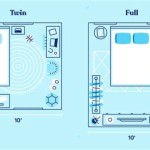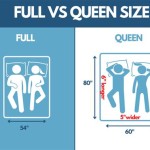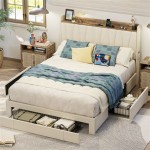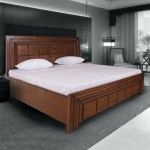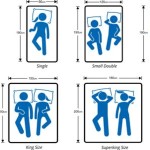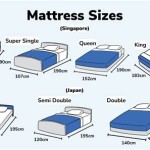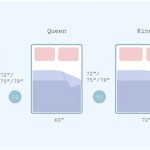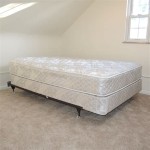Mattresses For A Full Size Bed: A Comprehensive Guide
The selection of a mattress for a full-size bed involves a careful consideration of factors ranging from individual sleeping preferences to budgetary constraints. A full-size bed, also known as a double bed, typically measures 54 inches wide and 75 inches long. This size is often favored by single adults, teenagers, or those with smaller bedrooms where space optimization is a priority. The variety of mattresses available in this size necessitates a thorough understanding of material types, construction methods, and potential benefits to ensure a comfortable and supportive sleep experience.
Understanding the nuances of different mattress types is crucial for finding the best fit. Each type offers its own unique set of characteristics related to comfort, support, temperature regulation, and durability. The following sections will delve into the most prevalent mattress types available for full-size beds, examining their respective advantages and disadvantages.
Innerspring Mattresses
Innerspring mattresses represent a traditional and widely recognized option. They are characterized by a core of metal coils that provide support and structure. The coils are typically surrounded by layers of padding, such as foam, cotton, or fiber, to offer a degree of comfort. The gauge and configuration of the coils can vary, affecting the overall firmness and support level of the mattress.
One of the primary advantages of innerspring mattresses is their affordability. They generally tend to be less expensive than other mattress types like memory foam or latex. The coil system also promotes airflow, which can contribute to better temperature regulation and reduce the likelihood of overheating during sleep. This makes innerspring mattresses a suitable choice for individuals who tend to sleep hot.
However, innerspring mattresses also have some drawbacks. The coil system can transfer motion readily, meaning that movement on one side of the bed may be felt on the other side. This can be disruptive for couples or individuals who share a bed with pets. Furthermore, innerspring mattresses may not conform to the body as closely as other mattress types, potentially leading to pressure points and discomfort for some sleepers. The durability of innerspring mattresses can also be a concern, with the coils potentially sagging or losing their support over time.
Memory Foam Mattresses
Memory foam mattresses have gained considerable popularity due to their ability to conform to the body's contours and provide pressure relief. Memory foam is a type of viscoelastic polyurethane foam that responds to body heat and weight, molding to the individual's shape. This conforming ability can help to alleviate pressure points on the hips, shoulders, and back, potentially reducing pain and improving sleep quality.
The density of the memory foam influences its firmness and support level. Higher-density memory foam tends to be firmer and more supportive, while lower-density memory foam is softer and more plush. Memory foam mattresses are often constructed with multiple layers of foam, with a denser support layer at the bottom and a softer comfort layer on top. This layered construction provides both support and cushioning.
A notable advantage of memory foam mattresses is their ability to isolate motion. The foam absorbs movement, reducing the likelihood of disturbances for sleeping partners. This makes memory foam a good choice for couples or individuals who are easily awakened by movement. However, memory foam can also trap heat, leading to overheating. Many manufacturers now incorporate cooling technologies, such as gel-infused memory foam or open-cell foam structures, to improve airflow and mitigate this issue. The initial odor associated with new memory foam, known as off-gassing, can also be a concern for some individuals. This odor typically dissipates within a few days.
Latex Mattresses
Latex mattresses offer a unique combination of comfort, support, and durability. Latex is a natural material derived from the sap of rubber trees. There are two main types of latex used in mattress construction: Dunlop latex and Talalay latex. Dunlop latex is denser and firmer, while Talalay latex is softer and more breathable. Both types of latex are known for their resilience and responsiveness.
Latex mattresses provide excellent support and conform to the body's contours without the sinking feeling associated with memory foam. They offer a good balance between pressure relief and support, making them suitable for a wide range of sleeping positions. Latex is also naturally hypoallergenic and resistant to dust mites and mold, making it a good choice for individuals with allergies or sensitivities.
One of the main advantages of latex mattresses is their durability. They tend to last longer than other mattress types, with some latex mattresses lasting for 10 years or more. Latex is also a breathable material that promotes airflow, helping to regulate temperature and prevent overheating. However, latex mattresses can be more expensive than other options. The weight of latex can also make them difficult to move or rotate.
Hybrid Mattresses
Hybrid mattresses combine the features of innerspring and foam mattresses to provide a balanced sleep experience. These mattresses typically consist of a coil support core topped with layers of memory foam, latex, or other cushioning materials. The coil system provides support and bounce, while the foam layers offer comfort and pressure relief.
The combination of coil and foam layers allows hybrid mattresses to offer a wider range of firmness and comfort options. The type and thickness of the foam layers can be adjusted to customize the feel of the mattress. Hybrid mattresses can also offer better motion isolation than traditional innerspring mattresses, as the foam layers help to absorb movement.
Hybrid mattresses can be a good choice for individuals who want the support of an innerspring mattress with the comfort and pressure relief of foam. They tend to be more expensive than innerspring mattresses but may offer a better value proposition in terms of comfort, support, and durability. The complexity of their construction can also make them heavier and more difficult to move.
Factors to Consider When Choosing a Full-Size Mattress
Beyond the basic mattress type, several other factors should be considered when selecting a full-size mattress. These factors include sleeping position, firmness preference, body weight, and budget. Taking these factors into account will help to narrow down the options and find the best mattress for individual needs.
Sleeping position is a critical determinant of mattress firmness. Side sleepers typically benefit from a softer mattress that conforms to the curves of the body and alleviates pressure on the hips and shoulders. Back sleepers generally prefer a medium-firm mattress that provides support for the spine and prevents it from sinking. Stomach sleepers often require a firmer mattress to keep their hips from sinking and prevent lower back pain.
Firmness preference is subjective and depends on individual comfort preferences. Some individuals prefer a plush, soft mattress, while others prefer a firm, supportive mattress. It is important to try out different firmness levels to determine which one feels the most comfortable. Many mattress retailers offer in-store trials or sleep trials that allow customers to test out a mattress before committing to a purchase.
Body weight can also influence mattress selection. Heavier individuals may require a firmer mattress to provide adequate support and prevent sinking. Lighter individuals may prefer a softer mattress that conforms to their body and provides pressure relief. It is generally recommended to consult with a mattress expert or read online reviews to get a sense of how a particular mattress performs for different body weights.
Budget is a significant factor for many individuals. Mattress prices can range from a few hundred dollars to several thousand dollars. It is important to set a budget and stick to it. While a more expensive mattress may offer better features or durability, there are also many affordable options that can provide a comfortable and supportive sleep experience. Consider sales events and promotions to potentially obtain a more expensive mattress at a reduced price.
Mattress Construction and Materials
The construction and materials used in a mattress can significantly impact its performance and durability. Understanding the different components of a mattress and their respective functions can help to make a more informed decision.
The support core of a mattress provides the primary support and structure. In innerspring mattresses, the support core consists of metal coils. The type and gauge of the coils can affect the firmness and support level of the mattress. In foam mattresses, the support core is typically made of high-density foam. The density of the foam determines its firmness and ability to resist sagging.
The comfort layers of a mattress provide cushioning and pressure relief. These layers are typically made of foam, latex, cotton, or fiber. The thickness and density of the comfort layers can affect the overall feel of the mattress. Softer comfort layers provide more cushioning, while firmer comfort layers offer more support.
The cover of a mattress is the outermost layer that encases the mattress. The cover is typically made of cotton, polyester, or a blend of both. The cover can affect the breathability and feel of the mattress. Some mattress covers are treated with antimicrobial or hypoallergenic finishes to protect against dust mites and allergens.
Edge support refers to the strength and stability of the mattress edges. Good edge support prevents the edges of the mattress from sagging and makes it easier to get in and out of bed. Edge support is often provided by reinforced coils or foam encasement along the perimeter of the mattress.
Mattress Certifications and Warranties
Mattress certifications and warranties can provide assurance of the quality and safety of a mattress. Looking for certifications from reputable organizations can help to identify mattresses that meet certain standards for materials, construction, and performance.
CertiPUR-US certification indicates that the foam used in a mattress has been tested and certified to be free of harmful chemicals, such as ozone depleters, heavy metals, and formaldehyde. This certification ensures that the mattress is safe for human health and the environment.
Global Organic Latex Standard (GOLS) certification ensures that the latex used in a mattress is made from organic rubber trees and meets strict environmental and social standards. This certification is important for individuals who are looking for an eco-friendly and sustainable mattress.
Oeko-Tex certification indicates that the textiles used in a mattress have been tested and certified to be free of harmful substances. This certification ensures that the mattress is safe for sensitive skin and does not contain any irritating chemicals.
A mattress warranty provides protection against defects in materials and workmanship. The length of the warranty can vary depending on the manufacturer and the mattress model. It is important to read the warranty carefully to understand the terms and conditions. Most warranties do not cover normal wear and tear or damage caused by improper use.

Full Mattress 8 Inch Z Hom Size Hybrid In A Box Foam Spring With Motion Isolation Pressure Relief Medium Soft

Zinus Cloud 12 In Tight Top Full Memory Foam Mattress Hd Cmm 1200f

Beautyrest Silver Brs900 Medium Pillow Top Full Mattress Set Size Regular Foundation

10 Inch Memory Foam Mattress Z Hom Hybrid Mattresses In A Box Medium Firm Cool Comfort Pocket Spring Full Size White

Sleep Options Mercer Full Size 12 In Gel Foam And Innerspring Mattress 413009 1130

Avocado Organic Mattress Rated Usa S Best Green

Full Size Mattresses Free Shipping 100 Night Trial

Elitespace Hybrid Full Mattress Memory Foam 10 Inch Size S
Full Size Mattresses Costco

Full Mattress Bednew 14 Inch Medium Firm Hybrid Pillow Top Mattresses In A Box Pocket Springs

